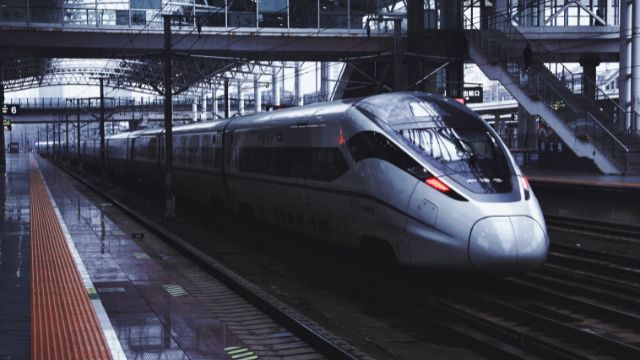In the recent days, India has progressed towards making the rail transportation better and more comfortable for the commuters. The bullet train project is one step closer to that goal. Not only the initiative, if successful, will take India to the next age of fast transportation, but also will solve the slow transport problem in various corners of the country. But is there all good and no risk behind this project? We offer you the specific sneak peek into the matter.
Advantages of the Bullet Train in India:

1. Speed and Efficiency:
Travelling between Mumbai and Ahmedabad faster is the bullet train’s major benefit. This high-speed train offers a two-hour travel at approximately 300 km/h. Unmatched efficiency and speed redefine pleasant travel and reinvent transportation. Bullet trains reduce commuter and traveller time constraints. Productivity, weariness, and passenger comfort have improved as we can perform what used to take hours in tenths. Today’s fast-paced world requires this speed edge. Modern technology makes Mumbai-Ahmedabad take two hours on the bullet train. Innovative train engineering and efficient operations set a new standard for quick, point-to-point connections. A significant reduction in travel time benefits commuters, visitors, and economic activity between these large cities.
2. Technological Advancements:
The bullet train introduced cutting-edge rail engineering, signaling, and safety innovations to India’s railway sector. Modern technology enhances travel and prepares the country’s transport infrastructure for future developments. Rail engineering advances technology. Modern engineering offers record bullet train speeds, efficiency, and safety. Rail is faster, more energy-efficient, and more sustainable due to better aerodynamics, materials, and propulsion systems. The bullet train’s advanced signaling systems are also impressive. Modern signaling equipment controls train movements accurately, decreasing accidents. These methods increase high-speed rail reliability and punctuality, improving transportation efficiency.
3. Economic Growth and Job Creation:
Start and completion of the bullet train project enhance India’s economy. Large infrastructure investments, a characteristic of the plan, stimulate several economic sectors. This prudent investment creates employment and boosts local development throughout the extensive rail line. Ripple effects may boost regional economies. The bullet train project funds crucial infrastructure, boosting the economy. This comprises high-speed rail construction and station, access road, and amenity modernization. Rail infrastructure improvements boost the economy and related businesses. This economic boost boosts job creation. The project needs skilled construction workers, planners, managers, and operators. This range of occupations lowers unemployment, benefiting bullet train towns’ economies.
4. Reduced Congestion and Environmental Impact:
A high-speed rail network might reduce vehicle and aviation traffic, changing mobility. More people use the quick, efficient bullet train may minimize other transportation needs. This might minimize car and air travel emissions and help the environment. High-speed rail eases traffic. Clogged highways may see fewer automobiles as commuters prefer the bullet train for speed and comfort. This decreases traffic, pollution, accidents, and road infrastructure strain. Impact extends beyond roadways to the skies. High-speed rail may cut short-haul flights, particularly between train-connected cities. This reduction in short-distance flight travel minimizes aviation pollution and congestion.
5. Global Connectivity and Tourism:
A high-speed rail network will boost international connectivity and globalization. India is popular with international tourists who want rapid, comfortable travel between major cities thanks to the bullet train. This may improve India’s tourism. High-speed rail links huge cities swiftly and easily, making it appealing. International tourists to India like the bullet train’s quickness between sites. Travellers may see more in less time with this speedy and efficient transit system. The bullet train connects India to the international tourism map. To see India’s diverse culture and landscape, international travellers may use the high-speed train network. This improved accessibility may boost tourism in India and diversify its economy.
Disadvantages of the Bullet Train in India:
1. High Construction Costs:
The bullet train’s high start-up cost is problematic. High-speed rail construction involves enormous technical, land, and development investments. Critics believe that the project’s vast expenditure may be utilized for education, healthcare, and poverty alleviation. Investment in high-speed rail technology, engineering, and safety measures boosts the bullet train project’s initial cost. Modern, sophisticated train systems need significant investment to guarantee efficient operations, safety, and a wonderful passenger experience. Critics claim transferring these funds may solve socioeconomic issues with limited resources.
2. Limited Reach and Accessibility:
Compared to conventional trains, point-to-point bullet trains are limited. Travellers outside this corridor may miss high-speed rail travel due to its basic architecture. Critics argue a more inclusive rail network reconstruction approach may benefit more people. Point-to-point bullet trains are condemned for their limited geographic reach. It connects huge cities, but it doesn’t meet the diverse transit needs of individuals outside the corridor. High-speed rail’s exclusivity limits its social impact and fails to serve all travellers, say critics. Upgrading the rail network is driven by the belief that it will benefit a larger and more diverse population. Critics say a focused deployment of money to upgrade and expand the network would be more inclusive and address rural and small community transit needs.
3. Ticket Pricing and Affordability:
High bullet train ticket costs have generated concerns that many people may be priced out. Price arrangements that favor the wealthy may undermine the goal of efficient and affordable travel for the majority. Ticket rates for bullet trains scare me. Critics argue high-speed rail travel may benefit the affluent if it is too expensive for most people. In a diverse society, this exclusivity questions the bullet train’s inclusivity. If managed poorly, ticket prices may exclude a huge population that may benefit most from an efficient and time-saving mode of transportation. The bullet train may reduce access to advanced transportation infrastructure, limiting its socioeconomic benefits.
4. Dependency on Foreign Technology and Expertise:
Japan-based technology and expertise are essential to the bullet train project. This dependency on foreign partners, particularly for cutting-edge technology and project maintenance, raises doubts about India’s sovereignty in executing and sustaining such projects. Critics say creating indigenous technology is necessary for self-sufficiency. The bullet train project has benefited from Japanese technology. Key partner Japan is famed for its high-speed rail technology and safety. Critics wonder how much India relies on international expertise for high-tech projects. The critique concerns geopolitical and sustainability risks of reliance.
5. Land Acquisition and Displacement:
High-speed rail infrastructure requires extensive land acquisition, raising worries about displacement and local repercussions. Land acquisition may be arduous and cost lives. Project execution is complicated by this delicate balance between development and local community protection. Resident displacement hinders land purchases. Due to their size, high-speed rail projects may involve community relocation. Involuntary relocation affects society, economy, and logistics. Large-scale infrastructure projects must respect displaced people’s rights and well-being.
Conclusion:
It is for sure that the bullet train is not a distant dream anymore. The fast progress of transportation technology has made bullet trains a near dream. For the proper economic growth of the country, such steps are essential in every way. If implemented in the right process, then bullet trains can be a perfect solution in the new generation India.
Santosh Kumar, the author behind IndiasStuffs.com, is passionate about sharing valuable insights on a variety of topics, including lifestyle, technology, and Indian culture.
Page Contents

